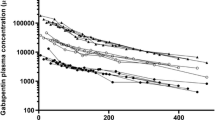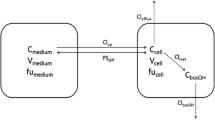Abstract
Objective: The buccal absorption of captopril does not exhibit the classical pH/partition hypothesis, suggesting that mechanisms other than passive diffusion are involved in its absorption; animal studies have suggested that a peptide carrier-mediated transport system may be responsible for its absorption. The present study evaluated the effects of pH on octanol partitioning, and on the buccal absorption of enalapril and lisinopril, using in vitro techniques and buccal partitioning in human volunteer subjects.
Methods: The partitioning of enalapril and lisinopril into n-octanol was examined over the pH range of 3–9 at room temperature.
Results: Enalapril exhibited maximal partitioning into the organic phase at pH 4–5; minimal partitioning was recorded at pH values 8 and 9. The partitioning of lisinopril into n-octanol was found to be maximal at pH 9 and minimal at pH 3. Using the buccal absorption technique, the partitioning of enalapril and lisinopril (0.5 mg), was examined in six healthy male volunteers from buffered solutions (pH 3, 4, 5, 6, 7, 8 and 9). In the case of enalapril, lowest buccal partitioning occurred at pH 3, 8 and 9, while maximal partitioning occurred at pH 5; absorption of lisinopril was not extensive at any pH, but was greatest at pH 6. These results, in addition to the n-octanol partition coefficients, indicated that enalapril obeyed the normal lipid partition hypothesis with respect to buccal absorption. The buccal absorption of lisinopril also obeyed the lipid partition hypothesis over the pH range 3–7. These findings are in direct contrast to those for captopril. The buccal partitioning experiments were repeated at the maximal pH for absorption for each angiotensin converting enzyme (ACE) inhibitor, but with the addition of cephradine (0.05 mmol · l−1).
Conclusion: The data indicated that the presence of this peptide transport inhibitor had no effect on the buccal absorption of enalapril (0.06 mmol · l−1) and lisinopril (0.057 mmol · l−1), which suggests that both drugs do not share a common buccal absorption pathway with cephradine.
Similar content being viewed by others
Author information
Authors and Affiliations
Additional information
Received: 2 January 1998 / Accepted in revised form: 31 May 1998
Rights and permissions
About this article
Cite this article
McElnay, J., Al-Furaih, T., Hughes, C. et al. Buccal absorption of enalapril and lisinopril. E J Clin Pharmacol 54, 609–614 (1998). https://doi.org/10.1007/s002280050522
Issue Date:
DOI: https://doi.org/10.1007/s002280050522




